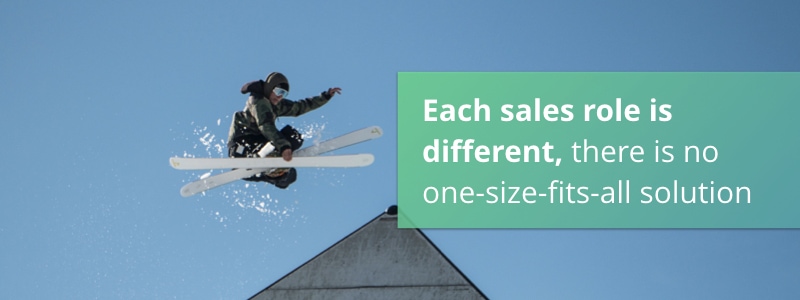As a sales manager, it’s your job to get the best performance out of each member of your sales team.
It's no secret that one of the best ways to do this is with a good sales commission program that rewards the behaviors you want to see, thereby creating a sales force that delivers on performance. A sales compensation plan that works enables you to retain your top salespeople, while also recruiting hungry new ones. probably the most important factor in creating a persuasive and competitive sales comp plan.
The best sales compensation plans are the ones with a solid framework. One adaptable to each member of your team, not to be mistaken for an overweight incentive plan.
That's because good sales managers know that each sales rep needs to be treated as a unique individual, keeping in mind their strengths their weaknesses. It is your job is to help them develop their strengths so they can perform better for the company and for themselves.
A great sales compensation plan motivates an entire organization to be one fully functioning unit, firing on all cylinders and learning how they can improve. Poor sales compensation can be the stuff of nightmares, leading to poor sales performance and, in worst-case scenarios, class action lawsuits.
So, there is a lot on the line when coming up with your sales performance structure. As sales compensation software experts, we've been down these roads. That's why we are proving this guide to help you create the best sales compensation plan for your organization.

Common Mistakes to Avoid When Developing a Sales Commission Structure
Sales commissions drive the top salespeople in your organization. The right mix of base salary, commissions, and incentives — fitted to the needs and talents of each member of your sales team — produces great results. But when you don’t get that mix right, or if your sales commission plan is poorly designed, the plan can actually harm your organization more than help it.
Some of the most common mistakes we see sales organizations make when designing a sales compensation plan are:
1. Using the Same Program Year After Year
Just because a sales program works well one year, that doesn’t necessarily mean you can use it again the next year. Markets change, your company’s organizational focus might change, sales reps come and go. Even if the program is the same, that doesn’t mean the underlying fundamentals are the same.
So your last plan was a great success — you still shouldn’t hesitate to make changes to the new plan if you think you can improve on last year’s performance. You should keep the elements that worked well, re-think the ones that didn’t, and perhaps add new elements based on current market conditions or those you see in the future. Break down your plan and look at it piece by piece. Then use this data to discover any weaknesses and find opportunities that you may have missed.

2. Not Taking Enough Time for the Planning Process
Too many sales organizations think they can throw together a sales compensation plan at the last second. This is a recipe for disaster. Organizations that don’t leave themselves enough time to look at and analyze the data or to take the time to get input from all significant stakeholders will end up with a plan that makes most people unhappy and pleases few.
Take your time. You want everyone working on your sales compensation team to play the same song in the end. That won’t happen if you only give them a week or two to learn the tune.

3. Making Things Way Too Complicated
When someone is pitching a movie to a film company, they have learned that they need to be able to summarize what their idea is all about in one or two sentences. Any longer and many film company executives won’t listen. The great Irish writer George Bernard Shaw once wrote a friend a letter and apologized, saying if he had more time, he would’ve written a postcard.
It’s somewhat the same idea with a sales compensation plan. Everyone in the organization, particularly the sales reps, needs to understand what the plan means for them and how it helps them achieve their individual goals. As a sales manager, part of your job is to communicate the plan to your sales reps. If the plan is too complicated and takes too long to explain, you most likely won’t get the results you want because your reps won’t understand what you wanted from them in the first place.

4. Starting With a Blank Sheet
Some sales organizations, regardless of how long they’ve been in operation, believe they have to start with a blank sheet every year when drawing up their sales compensation plan. In many ways, this is plain laziness. Organizations have a history and tradition and lots of data that can provide them with useful information to help design the very best sales compensation plan. Starting with “a blank sheet” every year is not a good idea. There is no need to reinvent the wheel.

5. Ignoring the Data
This mistake goes hand-in-hand with the mistake just mentioned. Organizations have data that shows how their sales reps have performed, whether or not they reached their quota, how they performed in each quarter of the year, how they dealt with old products or new products, and how they responded to previous sales compensation plans. When organizations ignore this data, they basically go into the sales compensation planning process blindfolded.
Instead of a well-crafted sales compensation plan, it becomes a “pin the tail on the donkey” plan. Just as the donkey’s tail could end up on the far wall, organizations could end up giving sales reps quarters and targets there either too high or too low and not appropriate for their territory or the product they sell. Pay attention to the data.

6. Only Analyzing How the Plan Is Performing Once a Year
A good sales commission plan is an organic document. Sales reps should be able to receive reports regularly on how they are performing in terms of the sales compensation plan. Executives will want to know if the sales compensation plan is producing the results the company needs.
Sales compensation plans need to be flexible and dynamic. You don’t have to start from scratch. Yet when you keep a constant eye on the plan and check it regularly, you will find that you can make tweaks in little fixes that will improve the plan and make it work better for everybody.

Level The Playing Field: Prepare Your Plan
Now that we’ve talked a bit about what not to do, let’s look at the steps you should take to prepare your sales compensation plan. When you’re creating a sales compensation plan, you want to include several different factors in the plan. Here are our suggestions about some of the essential things you need to consider:
1. Data, Data, Data
Data is the keystone of any successful strategic sales plan. It provides a window into past performance and, when broken down into its granular parts, gives organizations the opportunity to plan earlier. Data provides an organization with critical information on past sales performances and allows them to look over their strategies in motivating their sales representatives and see which strategies were the most successful in developing revenue.

2. Get the Right People Altogether in the Same Room
We can’t stress enough how crucial it is for the key stakeholders in your organization to back your sales commission plan. Get as many of them together as possible during the planning process. Executives are busy people, and so are the other people you would want to have part of this group.
Start the planning process three months before the beginning of the financial year. Then get the right people together to talk about sales compensation. Get executives from marketing, sales and operations. You need someone who can analyze the data properly. You should also include a sales rep or two who can give you feedback on how previous plans worked. Make sure participants receive the information they need before the meeting and have a chance to look it over. It’s also important not to blow off meetings. Be disciplined.

3. Make the Most Effective Use of Your Sales Plan
Your sales plan needs to come before your sales commission plan. It identifies how your team of sales representatives will achieve the company’s goals. It outlines capacity needs, the design of sales territory, and allocations of quota. Use data to design it so you’re not making “guesstimates.”

4. Plan Incentives Wisely
You will need to connect incentives with performance. Remember that conductor analogy we used above? Each person plays a different instrument — each sales role is different. People have different responsibilities. Incentives are not a one-size-fits-all solution. Adjust incentives for each role. Also, benchmark incentives against industry standards or you will lose top salespeople. Finally, you want your incentives to drive your sales team and motivate them.
Getting incentives right is difficult at times but crucial. The wrong incentive package will demotivate your team, not motivate them.
Remember the time you spend planning your sales commission process is time well spent. Give yourself enough time to analyze the data, create individual plans for each sales rep, and see how it fits into your overall sales plan before you bring it to your entire organization. This will help you execute and communicate your plan effectively.

5. Execute Your Sales Plan and Get Buy-In
If you build it, they won’t come unless you tell them about it. Communicating your sales commission plan is a vital step in creating a dynamic sales commission plan.
If you’re going to have a sales commission plan that works for everyone, from the C-suite to the sales rep on the street, you need buy-in from everyone. You want senior leadership to understand and approve the plan. A good sales commission plan will answer all their questions now rather than later. When done properly, the executives in your organization will feel as if they have a stake in the sales commission plan. That will encourage them to give it the appropriate support it needs.
Once the executives are happy with the sales commission plan, and the plan has been rolled out to the entire organization, it’s up to the sales manager to explain it to their team. This is why we advocate for a plan that avoids too much complexity. You want everyone in your team to understand how they benefit from the plan and the things that they’ll need to do to achieve those benefits.
Your sales commission plan should motivate and incentivize your sales representatives. Remember to provide them with regular reports on their performance. You will get buy-in from your sales reps when they understand what the sales commission plan means for them and how they can use it to their advantage. As a sales manager, your job is to answer all their questions. This means that you should understand and buy into the sales composition plan as well.

The Ready-Set-Go Sales Commission Framework
As we’ve noted elsewhere, designing a sales commission program for your organization can be a little bit like herding cats. Where do you start the planning process for a sales commission plan?
After you’ve outlined your goals, creating a shared language about sales compensation so participants understand the guiding principles of your program design, and received buy-in from key stakeholders, you need a framework to organize this information.
Performio has the framework you need. We call it the Ready-Set-Go sales compensation framework. These 15 steps provide you with a guide to creating an effective sales compensation program regardless of the size of your organization or the number of businesses for which you need to design a program.
The main thing about the framework is that it provides a step-by-step guide. Too many organizations approach their sales compensation plan haphazardly, not knowing where to start their planning process.
The first stage in the Performio plan is the "Ready" stage, which is composed of five steps:
- Purpose: What are your first principles?
- Principles: What design principles are the foundation for the plan?
- Total pay: What does the market say is the right level to pay your sales reps?
- Pay mix: What is the right mix for fixed and variable compensation?
- Pay curve: Do you want to be aggressive in terms of blown quota versus upside?

Once everyone agrees on these five steps, it will be easier to start designing your plan. The next step is the “Set” phase. It also has five steps:
- Measure: What performance measures will you use?
- Weighing: How will you weigh these measurements in terms of how important they are for the overall plan?
- Mechanics: How is performance connected to rewards? These are the calculations used to determine compensation.
- Timing: How regularly will you pay your sales reps?
- Quotas and targets: How do you assign quotas and targets to your sales reps? This is a critical element of your overall plan. Even if other parts of the plan work properly, if you get this part wrong, it can be disastrous.

The final stage is the “Go” phase. These final five steps deal with how you implement the sales compensation plan:
- Gather: Bring all your data together and create “a single source of truth.”
- Interrelate: Manage these new data relationships.
- Calculate: Run all the new calculations that underline and support the plan.
- Communicate: Tell everyone on your sales force about the plan so they understand it and how it will be implemented.
- Evaluate: Once the objectives of the plan are in place, every decision needs to be measured and evaluated against the objectives of the plan.
When companies are under pressure and don’t build in enough time to create a strategic sales compensation plan, they often go straight to the mechanics of the Set stage. Unfortunately, without the foundations and principles of your plan set in place and understood by the participants, your plan will not correctly generate the right calculations for sales compensation.

Performio Can Help You Develop a Successful and Effective Sales Compensation Plan
When you use the Ready-Set-Go framework, and Performio’s state-of-the-art commission tracking software, you’ll have an effective sales commission plan as well as a way for any member of your organization to see how the actual plan is working.
Performio’s software is available on your computer and your mobile device, whether it is a smartphone or a tablet. Your sales reps can see how they’re doing from anywhere and at any time. Performio’s software means you won’t need to use spreadsheets, an invitation for mistakes that can lead your company to lose hundreds of thousands of dollars by using the wrong sales compensation formulas each year. Performio allows you to motivate your sales representatives to do their very best.
To learn more about how Performio help you develop an effective and dynamic sales compensation plan that rewards your best people, and saves you money each financial year. Request a sales commission software demo today.
